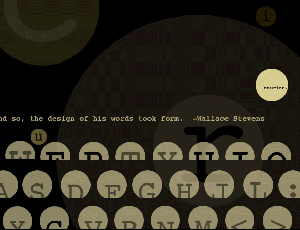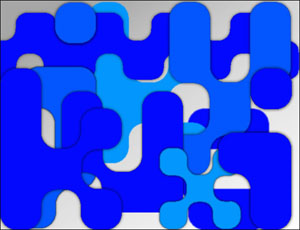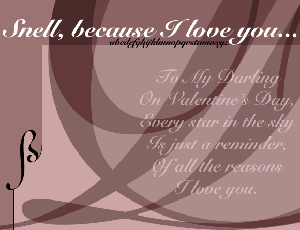Note: The deadlines dates below indicate when there will be in-class critiques of finished projects. For weeks in between these critique dates, be sure to look at the online class schedule to determine what to do for class each week. Many projects have interim stages (ie sketches or drafts) that we will look at in class.
Project 1:Typographic Word Poems
DEADLINE:
February 3- One Typeface Composition
February 17- Three More Typeface Compositions
Typography is the definitive tool of the graphic designer. This assignment
is geared toward encouraging personal expression through letter forms,
color, and layout. Choose 5 different typefaces. For each one that
you choose, create a composition that describes the typeface's personality, history, and essence. Elements of the composition can include the name of the typeface (and obviously you must use the typeface, but can also include other words and imagery. Your work should also endeavor to show your point of view. The compositions must be made as seperate layouts on separate files.
You will be using Adobe Illustrator.
  
|
|
Project
2:
Transportation Postage Stamp
DEADLINE: March 3
"Philately", or stamp collecting, is a popular hobby
partially because of the many ideas stamps embody. Designers are asked
to capture a nation's identity through its most interesting features,
people, and achievements. Your work in this assignment is to design
a stamp that commemorates a mode of transportation in a country and
time period of your choice.
Examples: a train in the American old west, the
French Concorde jet, hot air balloons, sailboats, the first moon landing,
etc.
Step ONE: Research
US stamps tend to be very conservative in design. Please check http://www.europeanstamps.net/ for ideas. You can use the seach function (under the images tab) of this site. Look especially at contemporary Dutch (Nederland) designs.
Step TWO: Sketch and Rendering
Sketch your design on paper and do your best to transfer the design
into Illustrator. You may scan the image and trace it. Work with color
and pattern in this phase. Create a finished rendering in Illustrator
to turn in.
|
Project 3:Transformation of Everyday Objects
DEADLINE:March 17
In
this assignment, you will work with serious constraints on compositional
elements to make a design with integrity. The challenge is to also make
the piece have variety. Choose an interesting household object. Try
to find an object that is relatively flat with a complex shape (scissors,
paperclips, paintbrushes, forks, etc.) Being careful not to scratch
the glass, place the object directly on the scanner and capture the
image.
Using only images of this object, create a composition in Adobe Photoshop.
The variety in the composition will come from exploring the options
that the software allows. Remember to also use combinations of effects
to achieve your goals. Some techniques you will want to explore are
selecting, copying, pasting, colorization, scaling, skewing, erasing,
rotating, and flipping the object. There are also filters and effects
to try out, but be original about their use and stay away from "preset"
manipulations. Make the final composition 8" x 10" at 150 dpi.
|
|
Project 4: Hybrid Class Portraits
DEADLINE: March 31
Who
are we? The concept of identity is tied to how we perceive ourselves and
to what others see when they look at us. In this assignment, you will
have a chance to deconstruct images of yourselves and your classmates.
How does changing one feature of a face in a portrait seem to distort
the notion of the sitter's identity?
This assignment deals with the notion of what we think
of as photographic truth. With the advent of digital imaging, it has become
even more problematic to say "I can see a picture of it so it must be
true!" Your goal with this assignment is to create a composite image that
looks like it was simply shot with a camera and printed photographically
with no computer manipulation. The material you will work with for this
assignment will be photographic portraits that we take in class. The general
idea is to create a "morph" in which you add characteristics from other
classmates. The goal is to blend facial characteristics together so that
we are creating another "set" of students who resemble our class but look
very different. The more you can transform your image into a new, hybrid
person the better.
Choose a picture of yourself to use as a base and
one or more photographs of other classmates.
Follow
these steps:
- Select the photograph of you to be the "master" image. This image will provide a basic framing for your hybrid image.
- Select one or more elements from another photograph
that you can realistically incorporate into your master image. In addition,
you may also have to change attributes of the master image.
- Using cut/paste, rubber stamp, layering, and subtle
color correction, try to make a seamless hybrid image in which no one
can tell what manipulations you did.
- When you present the work, be prepared to show
at least three images: (1) the new hybrid image (2) your master image
(3) your secondary images (Example: Using an image of your face as a
base, you add someone else's hairstyle, freckles, and nose.)
|
Project 5: Photocollage
DEADLINE: April 21
The goal of this assignment is to encourage experimentation in using imagery to create new meanings. Using high quality scans from your collection or from what is given in class, create a composition (11' x 17) in which the overall combination of imagery suggests something different from any of the constituent elements.
|
|
Project 6: Book Design
DEADLINE: May 19
The goal of this assignment it to gain experience
designing more traditional forms of pages like magazine or book formats. Use the text from Ellen Lupton's "The Bathroom, the Kitchen, and The Aesthetics of Waste" OR a text of your choosing (of approximately 2000 words) to make a multi-page
layout using InDesign.
You should read the content of the article closely and select photographs or illustrations to expand the ideas in the text. Be sure to rely on Master Pages and Style Sheets to make your design
uniform across the project. Choose typography that lends itself to legibility
and reinforces the meaning of the text. Especially important will be
the treatment of the type, its titles and its topic headings. Feel free
to experiment with non-traditional layout schemes.
Bookbinding resources:
PDFS:
Palm Size Press
Accordian Books
Basic Three Hole Pamphlets
Booklyn
“Creating a Sewn Binding”
supplies: embroidery thread, awl or sharp pointed instrument for small holes, clear nail polish (optional)
“Yellow & Green Softcover Exposed Spine”
supplies: same as above, with cardstock cover
“Coptic Stitch binding demo part 1”
supplies: same as above, with cardstock cover
“How to make a Pamphlet Book”
supplies: kitchen knife or bonefolder, candle or wax, thread, straight edge, awl or nail, needle, matte knife
“How To Make A Book”
When you have finished the layout, print out your book
and cover and bind it. It can be a standard or non-standard binding. WARNING::Give yourself plenty of time to do this part!
|
Final Exam Project: Extra Credit!!
DEADLINE: May 19
Your final exam meeting will consist of the presentation of a portfolio of all the semesters work.Aside from the book these shoudl be digital files. However, for extra credit, you may
make a print portfolio. For this, buy a plastic notebook that contains plastic sleeves.
This should contain:
1. Project 1 (5 pages)
2. Project 2 (2 pages- include the original sketch and final Illustrator image)
3. Project 3 (1 page Photoshop image)
4. Project 4 (2 pages- include one page layout of original class photos and one page with the final image)
5. Project 5 (1 page CD image)
6. Project 6 (2-5 pages- include your book covers, front and back, and additional impressive body pages)
|